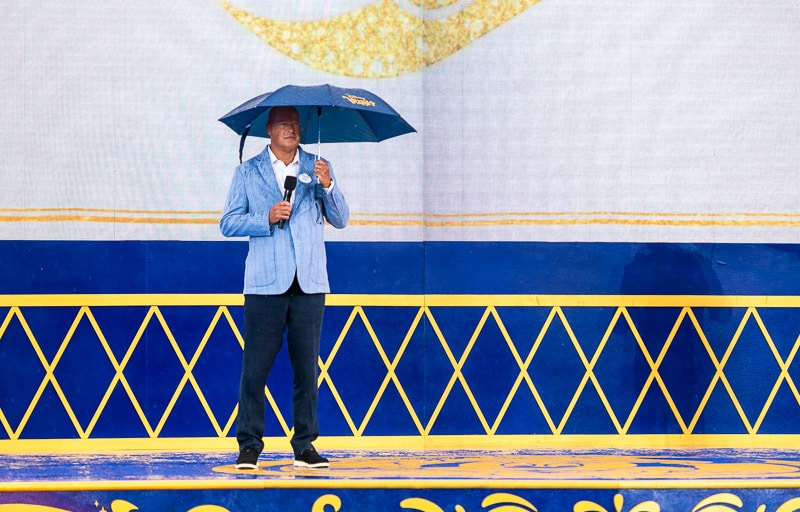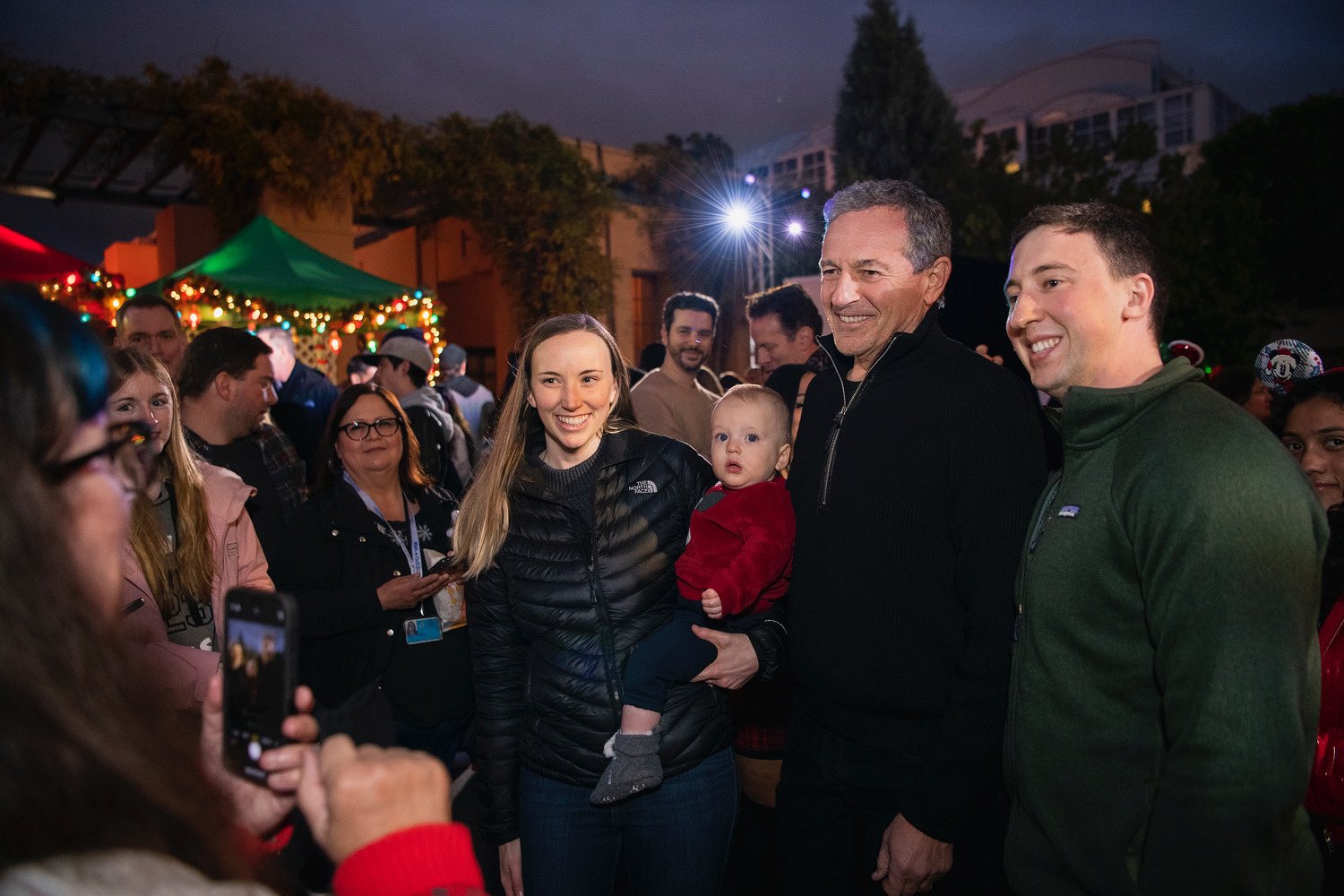
Disney’s recently-returned CEO Bob Iger sent a memo to employees requesting those currently with a hybrid work-from-home schedule spend four days a week in-office starting March 1, 2023. This post shares the memo plus our commentary about this move back to in-person work and its underlying motivations, whether it’s a layoff in disguise, and potential implications for Walt Disney World.
In the memo to Walt Disney Company employees, Bob Iger asked employees currently working a hybrid schedule to spend four days a week on-site, targeting Monday through Thursday as in-person workdays. As justification, Iger emphasized his belief in the benefit of working together in person because “creativity is the heart and soul of who we are and what we do at Disney.”
Iger explained that in a creative business like Disney, “nothing can replace the ability to connect, observe, and create with peers that comes from being physically together, nor the opportunity to grow professionally by learning from leaders and mentors. It is my belief that working together more in-person will benefit the Company’s creativity, culture, and our employees’ careers.”

This is one of several big organizational and structural changes that Bob Iger is expected to implement since returning to the Walt Disney Company shortly before Thanksgiving. Bob Iger wasted no time in reshaping Disney after returning as CEO, sending out his first memo to division leadership almost immediately upon returning. In that, Iger announced restructuring will begin “in the coming weeks.”
As part of that, Kareem Daniel, chairman of Disney Media and Entertainment Distribution and protege of Bob Chapek, was fired. In his memo to DMED, Iger said: “Over the coming weeks, we will begin implementing organizational and operating changes within the company. It is my intention to restructure things in a way that honors and respects creativity as the heart and soul of who we are. As you know, this is a time of enormous change and challenges in our industry, and our work will also focus on creating a more efficient and cost-effective structure.”

Even more germane to today’s news is Bob Chapek’s memo to executives back in November that “tough and uncomfortable” cost-cutting decisions would be made, including a hiring freeze, layoffs, and other austerity measures. That decision was met with intense internal backlash in Burbank, both for the substance of the news and the way it blindsided many leaders who were not given a heads up about the decision.
Shortly after returning to the helm, Bob Iger held a Cast Member Town Hall and was asked about that hiring freeze. “It felt like it was a wise thing to do in terms of the challenges, and at the moment, I don’t have any plans to change it,” Iger said at the time of the hiring freeze.
We’ll circle back to why this is significant in the commentary. First, here’s Bob Iger’s full memo to Disney employees:

Dear Fellow Employees,
Happy New Year! I hope you all found time to rest and recharge during the holidays.
Since returning to Disney, I’ve been busy catching up on the many exciting projects underway across all our businesses, and I have been inspired by your boundless creativity and the remarkable success of so many of your recent endeavors.
I thought I would mention a few:
For the 7th consecutive year, Walt Disney Studios was the number-one studio at the box office, and last week, Avatar: The Way of Water became the 7th highest grossing film of all time, and its success is only continuing to grow. The Lion King celebrated its 25th anniversary on Broadway in November — one of just three productions in history to achieve this incredible milestone. Disney General Entertainment shows received an industry-leading number of mentions across year-end “Best of” lists, including seven of the top 15 most critically acclaimed television shows of the year.
Disney Parks, Experiences and Products finished the year strong as guests celebrated their holiday traditions and rang in the new year at Disney destinations around the world, and Walt Disney Imagineering marked 70 years of groundbreaking innovation and storytelling. And I would be remiss not to mention how the ESPN team expertly handled Damar Hamlin’s tragic injury, showing grace under pressure, and presenting the facts to viewers with utter respect and sensitivity. Accomplishments like these remind me of how special our Company is.
I also wanted to let you know that, as I’ve been meeting with teams throughout the Company over the past few months, I’ve been reminded of the tremendous value in being together with the people you work with. As you’ve heard me say many times, creativity is the heart and soul of who we are and what we do at Disney. And in a creative business like ours, nothing can replace the ability to connect, observe, and create with peers that comes from being physically together, nor the opportunity to grow professionally by learning from leaders and mentors. It is my belief that working together more in-person will benefit the Company’s creativity, culture, and our employees’ careers.
Starting March 1, employees currently working in a hybrid fashion will be asked to spend four days a week on-site, targeting Monday through Thursday as in-person workdays. Stay tuned for additional details.
As we embark on a new year, Disney’s historic 100th anniversary, and all the opportunities before us, we have so many reasons to be excited about the future. Certainly, this is a moment of tremendous change — for our Company, for our industry, and for the global economy — but despite the challenges, at my core I remain an optimist.
Thank you. It’s an honor to be able to work alongside you.
Best,
Bob

When it comes to commentary, this will almost certainly add further fuel to the fire about work-from-home versus on-site offices. That offers a lot to unpack, including the future of employment, whether the pandemic represented a paradigm shift or temporary blip, arguably antiquated beliefs about in-person work and oversight, older v. younger generations of leaders, and so much more.
All of that is incredibly fascinating. Despite having worked remotely for the most part since college (and exclusively since 2014), I have a huge interest in this. It seems like there’s a new article in The Atlantic about WFH on a near-weekly basis, and I’ve read almost all of them. It’s an interesting topic and one that’ll undoubtedly shape the future of work-life balances, parenting, real estate, and so much more.
It’s definitely worth discussing, but not here, since that’s almost certainly not the impetus driving this decision.

Admittedly, this blog has skewed “pro-Iger” since his return to Disney in late November. (Definitely more so than prior to his departure, but part of that was seeing how much worse the alternative was!) With that said, we also have not taken his words at face value, and will not start doing so today.
Bob Iger can attempt to offer as much spin as he’d like about creativity and the benefits of meeting face-to-face or connecting in person. While I don’t doubt that some of that is sincere, I’m also highly skeptical that someone with the leadership chops and vision of Bog Iger actually buys what he’s selling here.
Much more likely is that this is about Chapek’s prior decision to make “tough and uncomfortable” cost-cutting decisions including a hiring freeze and layoffs. While there may not seem to be an ostensible nexus between the two, they are absolutely connected.

Many companies opted for work-from-home or hybrid work models during the pandemic for obvious reasons. Some corporations suggested that this would be permanent–and many employees surmised as much, assuming it was an accelerant to trends already set in motion. Consequently, many employees relocated to areas with cheaper cost-of-living or became accustomed to the lifestyles afforded by remote work.
As things started getting back to normal in late 2021 and early 2022, many companies began looking to bring back staff to offices and return to a more “normal” work environment. By and large, this failed. Workers revolted and threatened to change jobs (or did), and it became exceedingly easy for companies that were all-remote to poach talent from those pushing for in-office work. This resulted in many companies walking back their in-office demands. (Probably no need to over-explain all of this, as it’s been better and more comprehensively covered elsewhere.)

The salient point is that white collar workers who enjoyed the benefits of work-from-home would not return to the office for a variety of reasons. If backed into a corner with an ultimatum, many or most would find new jobs instead.
The key distinction between then and now is that many companies are not overly fixated on losing employees. To the contrary, several major U.S. corporations have announced hiring freezes or layoffs in anticipation of an economic downturn or recession. Many tech firms, including Meta/Facebook, Twitter, Netflix, Amazon, Salesforce, and others have culled their workforces to cut costs. This is being drive by persistent inflation, interest rate hikes, overhiring, and normalizing demand from the height of the pandemic. It has now spilled out beyond the high-growth tech industry, with other companies (Goldman Sachs did so just today) announcing layoffs.

What the Walt Disney Company is doing here is almost certainly aimed at reducing headcount, trimming its number of employees without the unpleasantness of layoffs. It wouldn’t be the first time in recent history–Imagineering’s (supposed) relocation to Lake Nona would be different means to the same end.
In fact, just as layoffs began in the tech industry and have spread to other companies, so too has this practice. Return-to-office mandates have been issued under the guise of greater efficiency, but really are disguised attempts to reduce staffing without layoffs. Employees who refuse to comply are treated as having quit, which allows a company to trim employee ranks without the negative headlines or cost of job cuts.
Given that Disney had a more flexible remote work policy than this for some positions before March 2020 alone suggests it’s not all about creativity, etc. The ultimate “tell” will be whether Disney grants exceptions to this policy–just as it did for the Imagineering relocation–for positions that are more difficult to fill and where employees have greater leverage. If those with more bargaining power are given exceptions, it’ll demonstrate that this is less about corporate culture, and more about evolving realities of the labor market and broader economy.

As for what this means for Walt Disney World visitors…probably not much at all. This also might come as a surprise. If you’ve read even a few posts here over the last two years, you’ve likely heard us blame this or that on staffing shortages. They’re the reason characters have been slow to return, restaurants still aren’t offering all meal services, and so much more. Staffing shortages have become something of a boogeyman (except real) for which we’ve blamed many if not most of Walt Disney World’s operational shortcomings.
While improving tremendously, staffing shortages remain a key impediment to fully normal operations at Walt Disney World. The company has had tremendous difficulty filling certain key roles, and turnover is incredibly high–even as Disney hires aggressively, it has been losing employees almost as quickly as it can onboard them. As a result of this, Disney has left money on the table–because it has literally been able to fill tables at restaurants, offer a full slate of upcharge offerings, etc.

Here, two things can be true at once. The Walt Disney Company wants to reduce its white collar employee headcount and Walt Disney World has a shortage of certain Cast Members in more guest-facing positions.
This in-office mandate will likely apply to employees at Team Disney Orlando (and Anaheim), but it’s not relevant to frontline Cast Members. That much should be obvious, since the waiters at ‘Ohana, ride operators during After Hours at Magic Kingdom, princesses at Akershus–and so forth–never could do any part of their jobs remotely.
Ultimately, it’s possible that Walt Disney World will also slow down the hiring of frontline Cast Members, weary of a shift from pent-up demand to a slowing economy. However, that is not what’s happening here–and it has yet to occur with frontline Cast Members. As of right now, Walt Disney World still has a full slate of open positions it’s trying to fill, including some with hiring bonuses, and has job fairs every Wednesday in January 2023.
Planning a Walt Disney World trip? Learn about hotels on our Walt Disney World Hotels Reviews page. For where to eat, read our Walt Disney World Restaurant Reviews. To save money on tickets or determine which type to buy, read our Tips for Saving Money on Walt Disney World Tickets post. Our What to Pack for Disney Trips post takes a unique look at clever items to take. For what to do and when to do it, our Walt Disney World Ride Guides will help. For comprehensive advice, the best place to start is our Walt Disney World Trip Planning Guide for everything you need to know!
YOUR THOUGHTS
What do you think about the Iger’s memo asking hybrid employees to return to the office? What about Iger’s supposed belief in the benefit of working together in person because creativity is the heart and soul of Disney? Thoughts on this being a layoff in disguise? Are you bullish or bearish about the company’s future as the Walt Disney Company enters its 100th year? Think things will get better or worse throughout 2023? Do you agree or disagree with our assessment? Any questions we can help you answer? Hearing your feedback–even when you disagree with us–is both interesting to us and helpful to other readers, so please share your thoughts below in the comments!





